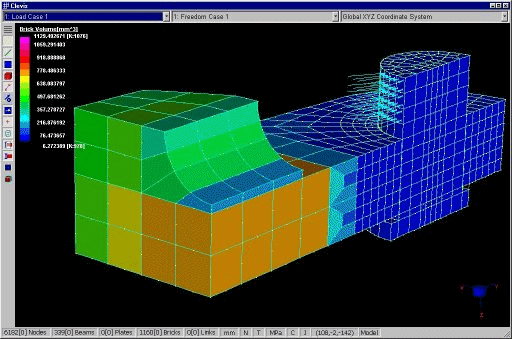

Dec 23, 2019; 3 min read; Ic3d Steel Download Included Crack Serial 32. A keygen is made available through crack groups free to download. When writing a keygen, the author will identify the algorithm used in creating a valid cd key. Once the algorithm is identified they can then incorporate this into the keygen. If you search a download site for Straus7 2.4.4 Keygen, this often means your download includes a keygen.
- If you need help,please mail to us
- EMAIL:crkteam@gmail.com
- Skype:dwcrk.com
- Rank?
- Size?44MB
- Language?Pre Release/English
- Platform?/WinNT/2000/XP
- Freshtime?2009-10-10
- Tag?
- Counts? Download Counts?
Straus7 lets you build models quickly. Create, delete and manipulate elements with a comprehensive set of tools, automated meshing and unlimited undo. Organise a complicated model into a simple set of parts using the Group Tree. Define your own coordinate systems and beam cross-sections. Check mesh quality with aspect ratio and warping contours and free edge detection.
Straus7 harnesses the power of Windows. Open multiple models at the same time. Cut-and-paste elements in 3D - even between models - and copy data to and from other Windows programs. Import geometry data from ACIS and DXF files. Choose drawing styles and colours. Set the physical units for viewing and entering data. Dynamically rotate, pan and zoom in real time with a single click
Straus7 gives you a range of result options. Visualise results with contour maps, vector maps and X-Y graphs. Use the Peek tool to inspect result quantities at any point, directly on the model. View, sort and filter results with the Result Listings spreadsheet.
Straus7 offers a full set of previewing and printing tools for documenting and reporting your work. Choose your own fonts, titleblocks and logos for a consistent, professional look across all your printing.
Extensive element library
1D: Beam, truss, spring, damper and cable elements
2D: Plane stress, plane strain, plate/shell, 3D membrane, shear panel and axisymmetric elements
3D: Tetrahedral, wedge, pyramid and hexahedral elements
Constraints: Rigid links, pinned links, master/slave links and contact elements (2D and 3D)
Comprehensive range of solvers
Static: Linear, buckling and non-linear (geometric, material and boundary non-linearity)
Dynamic: Natural frequency, harmonic response and spectral response
Transient: Linear and non-linear (geometric, material and boundary non-linearity)
Heat transfer: Steady-state and transient (linear and non-linear)
Standard and specialist materials
Linear and non-linear material models, including:Isotropic, orthotropic, anisotropic, soil, rubber, composite laminates and user-defined materials
Industry-standard data libraries
Materials: Engineering properties for common materials - steel, timber, aluminium, concrete and glass
Sections: Industry-standard cross-sections, including I-beams, tubes, channels and angles


- ÎÞÏà¹ØÐÅÏ¢

Crack Straus7 2017
| We offer Strand7 training courses approximately once a year, based on demand. The Strand7 courses have been developed by Strand7 head office over the past 15 years and are CPD accredited. We currently offer the following courses: We can also offer training in-house should there be sufficient demand. If you are interested in training, please contact dagmar@ally.co.za stating your contact details and modules in which you require training. | |
Strand7 Modules In More DetailModule 1 – Introducing Strand7 This provides a rapid introduction into using Strand7. It is intended for engineers with little or no previous experience in Strand7. It teaches how to create and verify finite element models, how to setup solvers (primarily Linear Static Analysis) and interpret the results using the post processing tools in Strand7. This module runs for 3 days. Module 2 – Nonlinear and Buckling Analysis This module addresses the need to undertake nonlinear analysis in structural and mechanical design, covering geometric, elastic-plastic and boundary nonlinearities. Linear and Nonlinear buckling using automatic load stepping is also addressed. Solver parameters are explained together with techniques for debugging nonlinear models. An introduction to construction sequence analysis using Strand7 is also given. Nonlinear analysis is increasingly used where the assumptions used in linear analysis are no longer valid. All structures exhibit nonlinear behaviour. Module 3 – Dynamic Analysis This module covers many aspects of dynamic analysis, including natural frequency, time history, harmonic response and spectral response methods. Concepts such as mode superposition are discussed and compared with full system analysis. Both linear and nonlinear dynamics are covered. Examples are taken from mechanical and structural engineering problems such as vibrating machinery and shock loads. Strand7 has new dynamics capability including the ability to do Fast Fourier Transforms (FFT) and solve for harmonic response time history. Module 4 – Structural Analysis This module is tailored towards the structural engineer wishing to perform static and dynamic analysis of structures. Various techniques for performing seismic analysis within Strand7 are covered. The use of advanced load applications, combinations and envelopes are covered through illustrative examples. Element types considered include beam, plate, membrane and 3D bricks for modeling such structures as building frames/slabs, suspension bridges and base plates. The concrete reinforcement module can be used to analyse and check the design of steel reinforcement on plate/shell elements. An overview of the capability of this module is presented in relation specific design codes. Module 5 – Automeshing The use of CAD in FEA is covered in this module, examples and discussions will include such topics as importing geometry from CAD packages, supported CAD packages and file formats. Strand7’s geometry cleaning tools will be used to repair CAD files prior to meshing. Surface and solid meshes will be generated and evaluated. Strategies for combining automatic and semi-automatic meshing using other Strand7 tools will be discussed. | |